This is the Best Time to Visit Yellowstone (And Worst)

Wondering when to pack your bags for Yellowstone National Park, the land of geysers, wildlife, and vast wilderness?
Having ventured through many national parks during my epic 5-month road trip, timing your visit can make all the difference. And having visited Yellowstone in May, right when the park opened most roads for the season again was one an amazing time to go.
The seasons here are so wildly different, from inaccessible snowy winters to perfect summers. Here’s a quick guide to help you decide:
- Peak Season: June to September
- Shoulder Seasons: May and September to October
- Off-Peak Season: November to April
Now, I’ll get into the details of each season, spotlight key events you won’t want to miss, and get you a month-by-month overview of the weather. Whether you’re planning a day trip to Yellowstone or a week long retreat, witness the eruption of Old Faithful or go on a wildlife safari, here’s what you need to know about the best time to visit Yellowstone National Park.
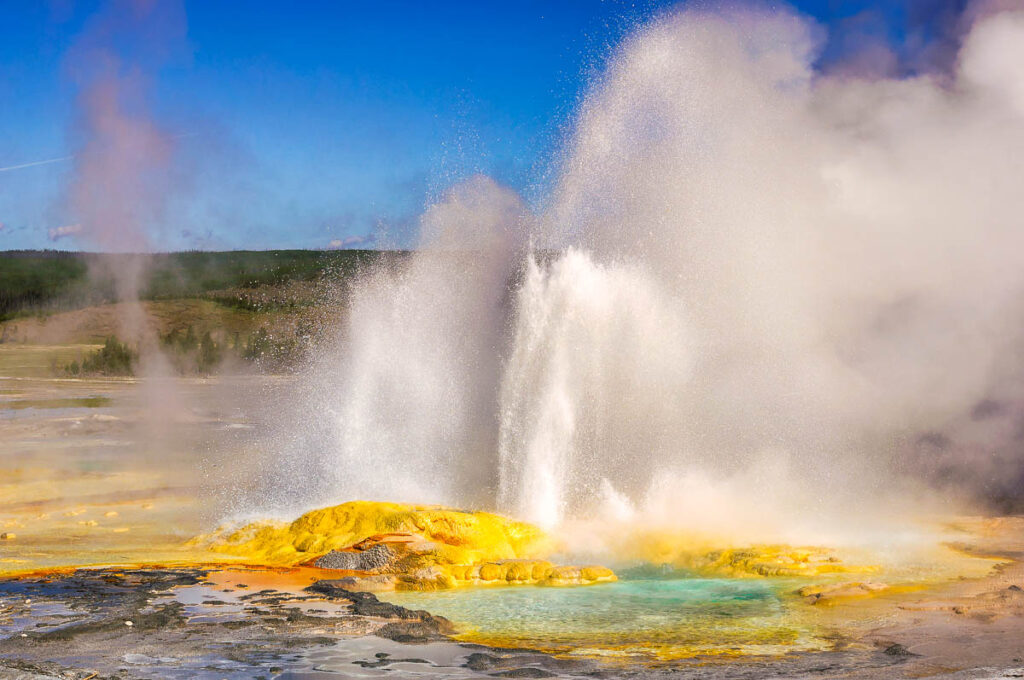
Best Time to Visit Yellowstone National Park
Best Time of Year to Visit
Yellowstone National Park is best visited from late May to September. These months offer the ideal weather conditions for hiking and observing wildlife, with temperatures varying between 30 to 60 degrees Fahrenheit.
Most crucially, the park remains open during this period, whereas for half of the year, it is largely inaccessible.
Best Time for Good Weather
For those chasing the sun and clear skies, the ideal window to go is from late June to early September. In May, I was definitely still wearing my full winter down jacket, except at the peak of the day.
But during this slice of summer, you’ll enjoy mild to warm days with temperatures comfortably sitting between 70°F and 80°F.
Best Time for Smaller Crowds
To beat the crowds, go from April to May and September to October. During these shoulder seasons, the visitor numbers dwindle to a fraction of the summer peak, with daily visits dropping to between 5,000 and 10,000 compared to the summer highs of over 30,000 visitors.
However, even in the shoulder months, you can find queues to enter the park and many others on the trails with you.
Cheapest Time to Visit
Unfortunately, the area around Yellowstone is never that budget-friendly unless you plan to camp. As accommodation is the highest expense, come during the shoulder seasons when sleeping outdoors is already comfortable but hasn’t reached its peak summer prices. Plus, you may be able to score some tour and activity prices at a lower price.
For most places, the off-season is the cheapest time to visit, but since the park is very inaccessible, extras like a snowmobile or snowshoe equipment actually increase the price of most winter activities.
Best Time for Stargazing
The best time for stargazing in Yellowstone is during the new moon phases from April through October when the skies are clearer, and the park’s remote location minimizes light pollution. This iconic park is recognized as an International Dark Sky Park, so especially in late summer, you’ll witness the Milky Way in all its glory.
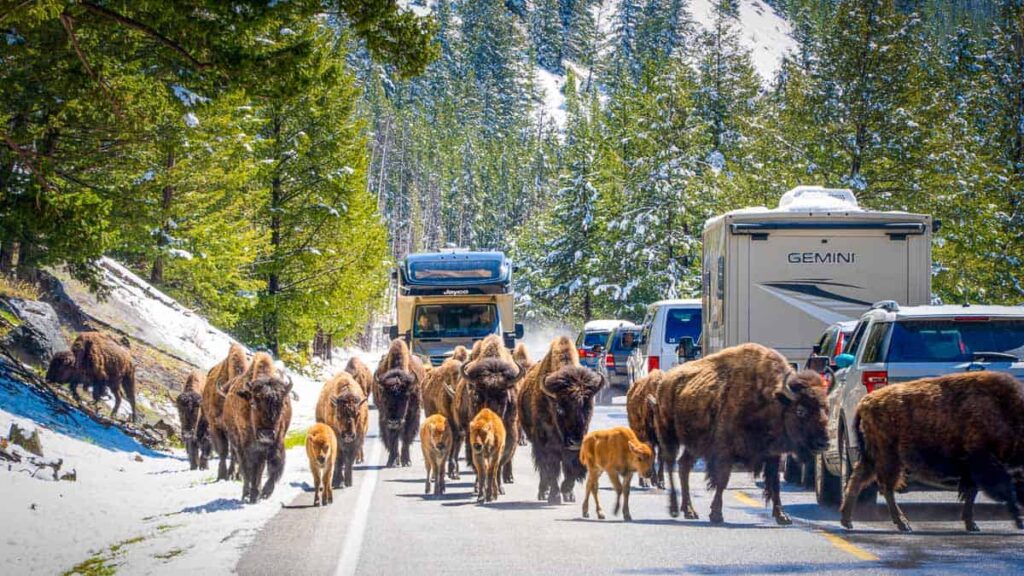
Worst Time to Visit
The winter months of November through early May can be tricky times to visit the park. The park is blanketed in snow, and the heavy snowfall can limit access to many attractions, including most geysers and trails. The temperatures also often plummet below freezing, making outdoor activities a challenge for those not fond of the cold.
Park Closures
Yellowstone welcomes visitors with varying operating hours throughout the year, but most facilities and roads close from early November through late April to mid-May. The only entrances open all year round are the two North Entrances.
This means that you won’t be able to drive from a trip to Grand Teton National Park of Jackson, Wyoming, to Yellowstone during the winter season.

Seasons at Yellowstone National Park
Spring (April to June)
Spring in Yellowstone comes late and is often overlooked by the summer crowds. It’s a time when the park’s famed wildlife, bears, wolves, bison, and elk, begin to emerge with their calves and cubs along their side.
The weather in spring is completely unpredictable, and the temperatures can swing from chilly 30°F mornings to pleasantly warm afternoons in the 60s°F. Snow lingers on many trails, especially at higher elevations, but the main roads to the geysers and popular trails start to open in mid-April for the season. This transitional period means fewer visitors.
Rivers and waterfalls roar to life with the snowmelt, making it a great time to see waterfalls like the Lower Falls of the Yellowstone River. The downside? Mud. Lots of it. My shoes were constantly soggy walking over the snowmelt, and some areas may still be inaccessible.
Summer (July to August)
As the snow melts and temperatures rise in July, the park reaches its peak summer season. The weather becomes consistently warm, with daytime temperatures ranging from 70°F to 80°F, though nights remind you you’re in high country with cooler 40s and 50s. The roads and trails are all open, and the whole park becomes accessible by car.
But Yellowstone is one of the busiest national parks in the whole country. Most visitors flock to the park in July and August, particularly during holidays like Independence Day weekend. Popular spots like Old Faithful, the Grand Prismatic Spring, and Mammoth Hot Springs can get swamped with visitors. You’ll also need to book accommodation well in advance if you want to stay in the park, as campsites and lodges fill up quickly.
Fire season kicks off in summer, too. The park’s ecosystem thrives on fire, but it can lead to temporary closures. Always check for the latest updates before heading to a specific area.
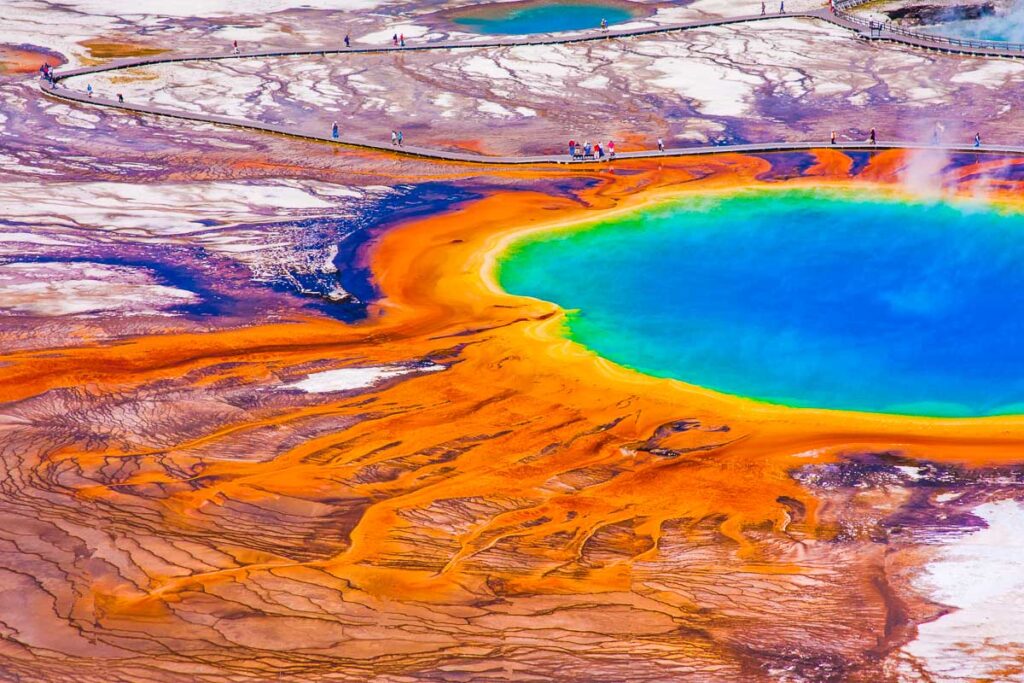
Fall (September to October)
As September rolls around, so do cooler temperatures. The crowds also begin to thin out as families head back home for school and work commitments.
The weather can be somewhat unpredictable during this time, with occasional snowstorms sweeping through the park, but it’s a great time to spot wildlife and avoid the crowds. The fall colors transform the park into a stunning display of oranges, yellows, and reds.
Some facilities begin to close after Labor Day, and by November 1, many roads start to close in preparation for winter. It may be quieter, but it limits your options for accommodation and activities.
Wildlife viewing in the fall is second to none. The animals are in their prime, and you can hear the bugles of bull elk echoing through the valleys with the elk rut. Bears are also more visible as they enter hyperphagia, foraging for up to 20 hours a day to prepare for winter hibernation.
Winter (November to March)
Winter in Yellowstone takes up nearly half the year. It’s the park’s quiet season, mainly most roads close to regular vehicles come winter, meaning access is mainly through guided snowmobile or snowcoach tours. These may be unique, one-of-a-kind adventures, but they are pretty expensive.
Surprisingly, winter may be one of the best times for wildlife watching. Animals like bison, elk, and wolves become easier to spot against the white backdrop. Many tours, for example, spend a full day dedicated to wolf searching in places like Lamar Valley.
Winter temperatures often dip below 0°F, especially at night, with day temperatures slightly warmer but still well below freezing. It’s not uncommon for the mercury to drop to -20°F in the coldest months of December and January. These frigid conditions require visitors to dress in layers, with thermal clothing, insulated boots, and heavy coats essential for staying warm.
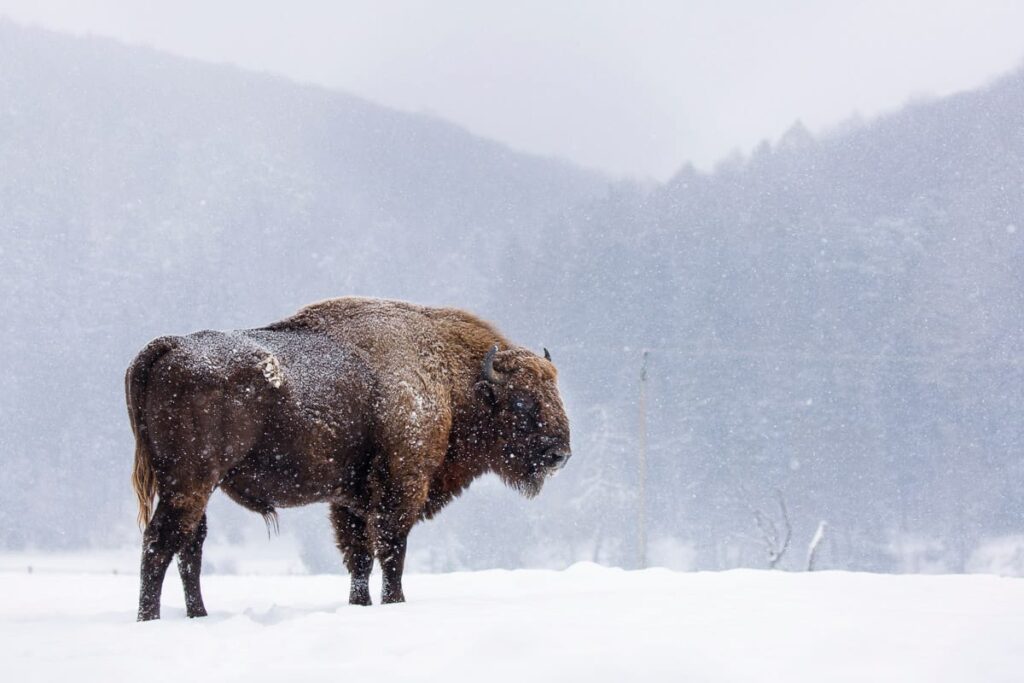
Yellowstone Weather By Month
This is a detailed month-over-month summary of the average maximum and minimum temperatures, rainfall, and snowfall at Yellowstone National Park:
| Month | Average High | Average Low | Precipitation | Snowfall |
| Jan | 25°F | 5°F | 0.2d | 11.8″ |
| Feb | 30°F | 7°F | 0.5d | 9.2″ |
| Mar | 38°F | 14°F | 1.3d | 7.4″ |
| Apr | 47°F | 23°F | 3.6d | 5.1″ |
| May | 55°F | 31°F | 8.7d | 2.0″ |
| Jun | 66°F | 38°F | 8.2d | 0.4″ |
| Jul | 75°F | 43°F | 5.8d | 0.0″ |
| Aug | 74°F | 42°F | 5.7d | 0.0″ |
| Sep | 64°F | 35°F | 5.1d | 0.4″ |
| Oct | 50°F | 27°F | 3.6d | 2.5″ |
| Nov | 35°F | 17°F | 1.7d | 8.8″ |
| Dec | 26°F | 8°F | 0.5d | 13.2″ |
Best Time of Day to Visit
My favorite time in Yellowstone is early morning, right after sunrise. It may be slightly still chilly in the morning, but there are much fewer people, and it ensures you won’t spend any time waiting in queue just to get into the park. Your chances of wildlife sightings are also much higher as animals are more active during these hours.
- Sunrise to Mid-Morning (5 AM – 10 AM): Expect quiet trails and active wildlife. Go to sunrise spots like Grand Prismatic Spring or the West Thumb Geyser Basin for stunning views without distractions.
- Midday (10 AM – 2 PM): This period sees peak visitor numbers, making popular spots crowded. It’s the warmest part of the day, perfect for longer hikes in cooler, shaded areas.
- Afternoon to Sunset (2 PM – Sunset): Crowds begin to thin, and the changing light can offer a new perspective on the landscape. Cooler temperatures make for comfortable exploring.
- Post-Sunset: For those who stay in the park after dark, go stargazing.
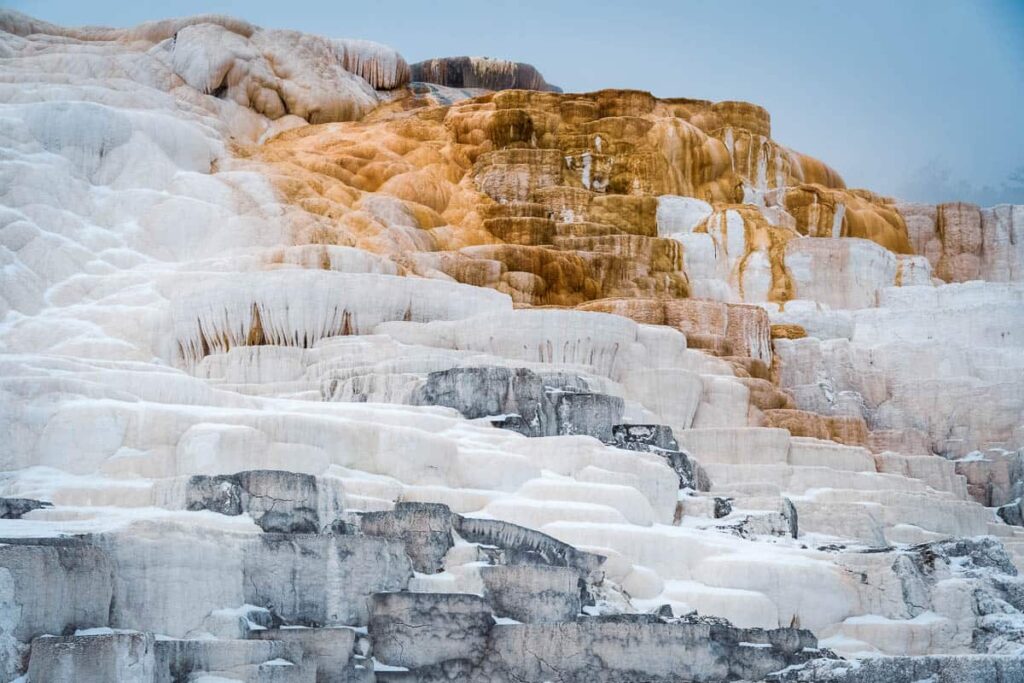
Special Events or Festivals
Below is a list of unique events and festivals taking place in or around Yellowstone:
- Fee-Free Entrance Days: Mark your calendar for these dates! Enter without an entrance fee on select days like January 15 (Martin Luther King Jr. Day), April 20 (First day of National Park Week), and June 19 (Juneteenth National Independence Day).
- Summer State Fair in Montana’s Yellowstone Country: Every August, vendors come to showcase their crafts and food in Billings, Montana.
- Sweet Pea Festival (August): Celebrate the arts, culture, and community in Montana’s Yellowstone Country. The festival is a blend of music, theatre, dance, and visual arts.
- Kids ‘N’ Snow: Specifically designed to get kids excited about the great outdoors during the winter months, this event in West Yellowstone offers a chance to learn about winter safety, snow sports, and wildlife.
- Jackson Hole Annual Festivals: Just south of the park, Jackson Hole is a popular ski area with events throughout the year. From music festivals to cultural celebrations, it’s worth checking out what’s on during your visit.
Before you Close That Tab…Where to Next in the Area?
Grand Teton and Yellowstone are amongst the most impressive places I’ve ever seen. I 100% understand why this is the oldest national park in the world. Here’s more information on this Wyoming area to help plan your journey.
Catherine, a seasoned travel writer, has lived in 4 different states and explored 36 states and 28 national parks. After spending two years embracing van life, she's now dedicated to sharing her vast knowledge of day trips across America. Catherine's other works has been referenced in major publications like MSN, Self, and TripSavvy.
| MY FAVORITE TRAVEL RESOURCES |
✈️ Find amazing guided tours and experiences with Viator to maximize your time! 🏘️ Plan ahead and secure your accommodation with Booking.com in advance. 🧾 Rent a car with Discovercars in advance and get the best prices for your day trip adventures. |

